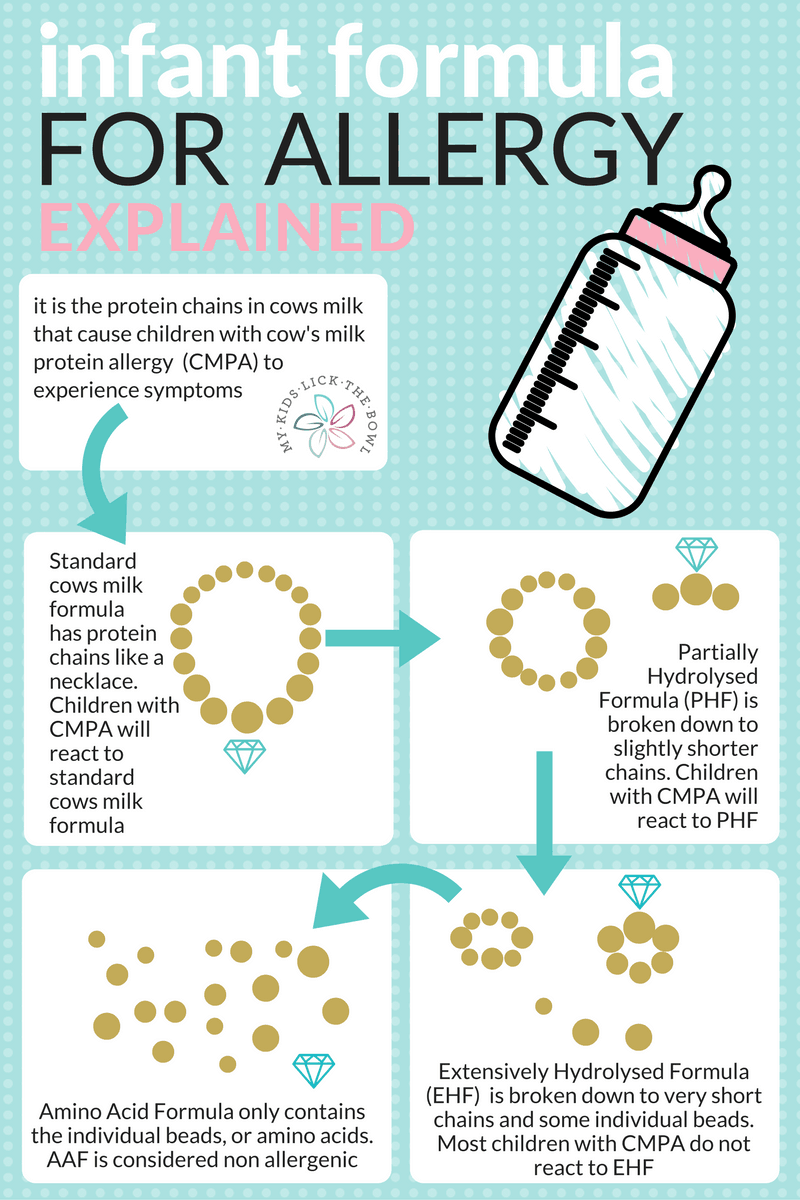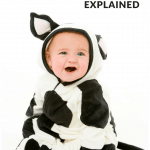Allergy Baby Formula
Baby formula for Cows Milk Protein Allergy
Cow’s Milk Protein Allergy (CMPA) is relatively common in babies. It is generally considered that one in fifty, or in other words, 2 percent of babies have an allergy to cow’s milk protein.
There are a number of allergy baby formula available for these babies. In this article I will take you through the different types of allergy baby formula and explain what they are.
Cow’s Milk Protein Allergy
The first point I want to get across is that cow’s milk protein allergy does not always present in the same way for all babies.
There are a couple of mechanisms in the body that can cause the reaction. Which means different babies with cows milk protein allergy can experience very different symptoms.
I think one of the best information sources for CMPA is the Australasian Society of Clinical Immunology and Allergy (ASCIA). They have a great patient fact sheet on cow’s milk allergy which I think is the perfect starting point if you are a parent worried your child might have CMPA
In a nut shell, Some babies will react very quickly after having small amounts of cow’s milk, like within minutes. Others may not show symptoms until days after having what we would call a normal amount of cow’s milk. And some fall somewhere in between.
Symptoms may or may not include: Hives, face swelling, wheezing, eczema, vomiting, diarrhoea and in the most severe cases anaphylaxis or floppy baby syndrome
What I am trying to say is, if you suspect your child may have CMPA then please see a Health Care Professional to confirm the diagnosis and come up with a management plan for your baby. Because allergy babies are all different.
Now that I have covered that off, I will get on to the baby formulas used for CMA
Allergy Baby Formula Types
Goats Milk infant formula
Goats milk is not considered a suitable alternative for babies with cows milk protein allergy by the majority of health care professionals and the latest clinical guidelines. A large number of children that react to cows milk protein will also react to goats milk protein.
In fact, I remember listening to a presentation one day by a leading Paediatric Allergist (Dr. Jan Sinclair). Her comment about goats milk and cows milk in terms of allergy has always stuck with me. She said basically all mammalian milks were so similar in composition/allergenicity that none of them would be acceptable as an alternative for a child with cows milk allergy.
Her only exception was camel milk. Unfortunately however, camel milk infant formula is not readily available.
Soy infant formula
Soy formulas use Soya bean as a protein source. Although soy formula is cows milk protein free, a number of guidelines on the management of cows milk protein allergy do not recommend soy as first choice alternative to cows milk allergy particularly in babies under 6 months of age.
If you suspect cows milk protein allergy in your child it is generally best to seek advice from a health care professional before making decisions regarding which formula to use.
Hydrolysed Protein Infant Formulas
These are formulas where the protein source (typically cows milk protein) has been altered to make the protein chains shorter. If you imagine protein chains are like long necklaces made up of beads, hydrolysed formulas have protein chains which are shorter than the original long necklace.
There are 2 categories of hydrolysed formula. (The degree of hydrolysation will be described on the label)
Partially Hydrolysed infant formula
If we think back to our long necklace analogy, then Partially Hydrolysed Formula (PHF) have protein chains which are a bit shorter than the original. So instead of a full length necklace the protein chains may be equivalent to a short choker style necklace.
PHF are readily available in supermarkets within Australia and New Zealand. PHF were designed to be used as a protective measure for children at high risk of developing cows milk protein allergy. i.e. for a baby where there is a strong family history of cows milk protein allergy.
If your baby already has developed an allergy to cows milk protein then a PHF is not considered to be a suitable treatment option. For a child with diagnosed cows milk protein allergy the protein chain lengths are still long enough to cause a reaction.
Extensively Hydrolysed infant formula
Extensively Hydrolysed Formula (EHF) have protein chains that are broken down to shorter chain lengths than partially hydrolysed formula.
Save This Recipe!
Think bracelets and rings. EHF were until relatively recently only available through pharmacies. They are now available online and in supermarkets. EHF are used as a treatment option for babies with cows milk protein allergy. As the protein chains are much shorter than standard cows milk formula they are generally tolerated by babies with a cows milk protein allergy.
If your family has a strong history of allergy, such as your baby has a sibling with diagnosed cows milk allergy, then an EHF may also be a reasonable choice as a protective measure against developing allergy.
Although EHF are now more easily accessible, I would still urge parents to seek advice from a healthcare professional if they suspect cows milk protein allergy in their baby.
Some babies with a cows milk allergy may still react to the protein chains in EHF and may need an Amino Acid Formula (See Below). EHF formula are also used by healthcare professionals to manage the nutrition needs of babies with medical problems which affect their digestive tract and ability to absorb nutrients.
Amino Acid infant formula
Amino acid formula (AAF) are not available within supermarkets, they are a pharmacy only product. Amino acids are the building blocks of protein chains. Once again if I go back to my necklace analogy, then amino acids are the individual beads that make up the necklace.
AAF are used for the treatment of cows milk protein allergy. This type of formula is considered to be 100% non allergenic, so can be used for the treatment of cows milk protein allergy even in the most severe cases. AAF are also used by healthcare professionals to manage the nutrition needs of babies with medical problems which affect their digestive tract and ability to absorb nutrients.

Lactose free infant formula
Lactose free formula is not an appropriate formula for babies with CMPA.
Lactose intolerance and CMPA are too very different issue although both caused by Cow’s Milk.
Lactose is the naturally occurring carbohydrate found in both breast milk and cows milk. Lactose free formula are typically cows milk formula that have had the lactose removed and replaced with an alternative carbohydrate source. Lactose free formula still contain CMPA
Lactose Intolerance or CMPA?
I will start with a a quick biochem/physiology lesson. Lactose is the naturally occurring sugar found in both breast milk and cows milk.
To be digested lactose needs to be broken down by an enzyme called Lactase. The lactase enzyme lives in our small bowel. In a person with lactose intolerance, there is not enough of the lactase enzyme in the small bowel to digest the lactose they eat.
This leads to bloating, gas and pain. Some people simply do not make enough lactase to manage having lactose in their diet, for some people this is a life long issue.
Sometimes a baby can experience lactose intolerance that might only be short term in nature.
Examples of short term lactose intolerance
- Some prem babies cannot manage lactose as their body hasn't started making lactase yet
- Some breastfed babies can struggle to keep up with the amount of lactose in their mothers milk in the early days. This is often not because they have a deficiency in lactase, but because they are receiving more lactose than they can handle. You may have heard about fore milk and hind milk. Breast milk differs in composition during a feed, it starts off high in carbohydrate (Lactose) at the beginning, then changes to higher in fat. A new born breastfed baby sometimes does not manage to feed long enough on the breast to get the high fat part of the milk, so its little gut becomes 'overloaded' with lactose. This usually resolves itself once your supply balances out and should not be a reason for switching from breastfeeding to lactose fee formula.
- Removing dairy from your diet does not change the lactose content of your breast milk. Even if you are eating no dairy your body will still make breast milk that contains lactose. Sometimes expressing some milk off before you feed your baby can help, or 'block feeding' this is when you only offer one breast for four hours, this makes sure babie will be getting some of the higher fat milk and therefore less of a lactose load.
- Sometimes if a babies gut becomes 'damaged' (I use the term damaged very loosely) , i.e. after a bout of gastro or after taking antibiotics, it can mean for a short while their gut may not be producing lactase as it should. This typically resolves after a little while, and does not mean your baby will be lactose intolerant for life. In these cases if you are formula feeding a lactose formula may be useful in the short term, but shouldn't be needed long term.
And the last part of my rant. Lactose Intolerance and Cows Milk Protein Allergy are two very different things. Although I hear many parents and even health care professionals confusing them.
As described above, lactose intolerance is due to the body not being able to break down the carbohydrate (lactose) content of milk. Cows milk protein allergy is when the body has an immune response to the protein component of cows milk.
A lactose free formula is not an appropriate treatment for cows milk protein allergy. For this reason, if you suspect either cow's milk or lactose intolerance in your baby, please seek medical advice before starting specialised formula.
So there we have it a summary of the formula for babies with cow’s milk allergy.
I spoke about 6 baby formula types: Goat, Soy, Lactose Free,Partially Hydrolysed, Extensively Hydrolysed and Amino Acid.
In essence, though this list can be cut down by half. As only 3 are suitable for the treatment of cows milk protein allergy. These are Extensively Hydrolysed, Amino Acid and Soy (in some cases)
I hope this was useful. If you are concerned your baby may have cow’s milk protein allergy then please speak with a Health Care Professional.


To say that goats milk infant formula has no benefit over cow's milk for allergy is not quite correct. Goat milk has much less alphas1-casein and more beta-casein compared to cow milk. Goats formula can provide similar benefits to hydrolysed cow's milk formulas. Important though to make sure cow's whey protein has not been added to the goat milk formula. Some brands have been known to do this.
I disagree on this point. I do agree that there is a difference in digestibility which I discuss. But from an allergy perspective the current guidelines form allergy professional bodies do not recommend goats milk as a treatment for cows milk allergy as the cross reactivity between goats milk and cows milk is exceptionally high.